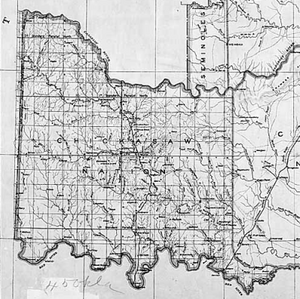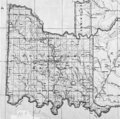Chickasaw Nation facts for kids
Quick facts for kids
The Chickasaw Nation
Chikashsha I̠yaakni' (Chickasaw)
|
|||
|---|---|---|---|
|
|||

Location (red) in the U.S. state of Oklahoma
|
|||
| Constitution | August 30, 1856 | ||
| Capital | Tishomingo, Oklahoma (Historically) Ada, Oklahoma (1907-Present) | ||
| Area | |||
| • Total | 7,648 sq mi (19,810 km2) | ||
| Population
(2010)
|
|||
| • Total | 38,000 | ||
| Demonym(s) | Chickasaw | ||
| Time zone | UTC−06:00 (CST) | ||
| • Summer (DST) | UTC−05:00 (CDT) | ||
| Area code(s) | 580, 405 and 572 | ||
The Chickasaw Nation (Chickasaw: Chikashsha I̠yaakni) is a federally recognized Native American tribe, with its headquarters located in Ada, Oklahoma in the United States. They are an Indigenous people of the Southeastern Woodlands, originally from northern Mississippi, northernwestern Alabama, southwestern Kentucky, and western Tennessee. Today, the Chickasaw Nation is the 13th largest tribe in the United States.
Currently, the nation's jurisdictional territory and reservation includes about 7,648 square miles of south-central Oklahoma, including Bryan, Carter, Coal, Garvin, Grady, Jefferson, Johnston, Love, McClain, Marshall, Murray, Pontotoc, and Stephens counties. These counties are separated into four districts, the Pontotoc, Pickens, Tishomingo, and Panola, with relatively equal populations. Their population today is estimated to be 38,000, with the majority residing in the state of Oklahoma.
In the 17th and 18th centuries, European Americans considered the Chickasaw as one of the historic Five Civilized Tribes, along with the Cherokee, Choctaw, Muscogee, and Seminole nations, due their agrarian culture and later adoption of centralized governments with written constitutions, intermarriages with the white settlers, literacy, Christianity, market participation, and slave holding.
The Chickasaw language, Chikashshanompa’, belongs to the Muskogean language family. This is primarily an oral language, with no historic written component. A significant part of their culture is passed on to each generation through their oral history, consisting of intergenerational stories that speak to the tribe’s legacy and close relationship with the Choctaw. The similarities in the language of the Chickasaw and the Choctaw have prompted anthropologists to propose a number of theories regarding the origins of the Chickasaw Nation as it continues to remain uncertain.
Clans within the Chickasaw Nation are separated into two moieties: the Impsaktea and the Intcutwalipa, with each clan having their own leaders. Their tradition of matrilineal descent provides the basic societal structure of the nation, with children becoming members and under the care of their mother’s clan.
Contents
Economy
The Chickasaw Nation operates more than 100 diversified businesses in a variety of services and industries, including manufacturing, energy, health care, media, technology, hospitality, retail and tourism. Among these are Bedré Fine Chocolate in Davis, Lazer Zone Family Fun Center and the McSwain Theatre in Ada; The Artesian Hotel in Sulphur; Chickasaw Nation Industries in Norman, Oklahoma; Global Gaming Solutions, LLC; KADA (AM), KADA-FM, KCNP, KTLS, KXFC, and KYKC radio stations in Ada; and Treasure Valley Inn and Suites in Davis. In 1987, with funding from the US federal government, the Chickasaw Nation operated just over thirty programs in hopes of eventually reaching the state of being in a firm financial base. Today, the nation has more than two hundred tribally funded programs as well as more than sixty federally funded programs providing services from housing, education, entertainment, employment, healthcare, and more.
Governor Anoatubby highly prioritizes the services available to the Chickasaw people. Two health clinics (in Tishomingo and Ardmore), as well as the Chickasaw Nation Medical Center, was established in Ada, Oklahoma in 1987. Not long after, many more health clinics and facilities have opened as well, with even a convenient housing facility on the campus of the Chickasaw Nation Medical Center designed to relieve families and patients of travel and lodging costs if traveling far from home. Increases in higher education funding and scholarships have enabled many students to pursue higher education, with funding increasing from $200,000 thirty years ago to students receiving more than $15.6 million in scholarships, grants, and other educational support. The Chickasaw Nation is also contributing heavily to the tourism industry in Oklahoma. In 2010, the Chickasaw Cultural Center opened, attracting more than 200,000 visitors from around the world as well as providing hundreds of employment opportunities to local residents. In this year alone, the Chickasaw Nation also opened a Welcome Center, Artesian Hotel, Chickasaw Travel Shop, Chickasaw Conference Center and Retreat, Bedré Fine Chocolate Factory, and the Salt Creek Casino. In 2002, the Chickasaw Nation purchased Bank2 with headquarters in Oklahoma City. It was renamed Chickasaw Community Bank in January 2020. It started with $7.5 million in assets and has grown to $135 million in assets today. The Chickasaw Nation also operates many historical sites and museums, including the Chickasaw Nation Capitols, and Kullihoma Grounds, as well as a number of casinos. Their casinos include Ada Gaming Center, Artesian Casino, Black Gold Casino, Border Casino, Chisholm Trail Casino, Gold Mountain Casino, Goldsby Gaming Center, Jet Stream Casino, Madill Gaming Center, Newcastle Casino, Newcastle Travel Gaming, RiverStar Casino, Riverwind Casino, Treasure Valley Casino, Texoma Casino, SaltCreek Casino, Washita Casino and WinStar World Casino. They also own Lone Star Park in Grand Prairie, Texas and Remington Park Casino in Oklahoma City. The estimated annual tribal economic impact in the region from all sources is more than $3.18 billion.
History
Hernando de Soto is credited as being the first European to contact the Chickasaw, during his travels of 1540. He discovered them to have an agrarian society with a sophisticated governmental system, complete with their own laws and religion. They lived in towns.
In 1797, a general appraisal of the tribe and its territorial bounds was made by Abraham Bishop of New Haven, who wrote:
The Chickasaws are a nation of Indians who inhabit the country on the east side of the Mississippi, on the head branches of the Tombeckbe (sic), Mobille (sic) and Yazoo rivers. Their country is an extensive plain, tolerably well watered from springs, and a pretty good soil. They have seven towns, and their number of fighting men is estimated at 575.
The Chickasaw remained in their homelands of western Tennessee and northern Mississippi until the 1830s. After decades of increasing pressure to cede their land from the Federal and state governments, the Chickasaw finally agreed to cede their remaining Mississippi Homeland in the Treaty of Pontotoc Creek and relocate west to Indian Territory.
During Indian removal of the 1830s, the United States government first assigned the Chickasaw to a part of Indian Territory west of the Mississippi River controlled by the Choctaw Nation; their area in the western area of the nation was called the Chickasaw District. It consisted of Panola, Wichita, Caddo, and Perry counties.
Although originally the western boundary of the Choctaw Nation extended to the 100th meridian, virtually no Chickasaw lived west of the Cross Timbers, due to continual raiding by the Plains Indians of the southern region. The United States eventually leased the area between the 100th and 98th meridians for the use of the Plains tribes. The area was referred to as the "Leased District".".
The division of the Choctaw Nation was ratified by the Choctaw–Chickasaw Treaty of 1854. The Chickasaw constitution establishing the nation as separate from the Choctaws, was signed August 30, 1856, in the new capitol of Tishomingo (now Tishomingo, Oklahoma). The first Chickasaw governor was Cyrus Harris. The nation consisted of five divisions; Tishomingo County, Pontotoc County, Pickens County, and Ponola County. Law enforcement was by the Chickasaw Lighthorsemen, although non-Indians fell under the jurisdiction of the Federal court at Fort Smith.
Following the Civil War, the United States forced the Chickasaw into new peace treaties because of the support of many of the Five Civilized Tribes for the Confederacy. Under the new treaty, the Chickasaw (and Choctaw) ceded the "Leased District" to the United States. In 1868, the Chickasaw Montford T. Johnson, with Jesse Chisholm's help, secured an agreement with the Plains tribes to establish a ranch on the new western edge of the Nation. His ranch was never raided, although often threatened. He and his family remained the only permanent residents of the area until the settlement of Oklahoma after it was admitted as a state.
Under the Dawes Act, the Chickasaw nation was dissolved, with government functions transferred to the federal government before statehood, by agreement negotiated with the Dawes Commission. Following the breakup of the nation, the Chickasaw became citizens of the United States. The US allotted the communal land in plots for individual households of registered members. Land left over was declared "surplus" and made available for sale to non-Indians, so they lost much of their tribal lands.
In the second half of the 20th century, the Chickasaw reorganized their tribal government. They adopted a new constitution on August 27, 1983 to manage their business affairs.
Notable people
- Bill Anoatubby, Governor of the Chickasaw Nation since 1987
- Jodi Byrd, Literary and political theorist
- Jack Brisco and Gerry Brisco, pro-wrestling tag team
- Stephanie Byers, the first Native American openly transgender person elected to office in America
- Jeff Carpenter, recording artist and co-founder of the Native American music group Injunuity
- Edwin Carewe (1883–1940), movie actor and director
- Charles David Carter, U. S. Congressman from Oklahoma
- Travis Childers, U.S. Congressman from Mississippi
- Helen Cole (1922-2004), mayor of Moore, state representative, state senator, daughter of Te Ata Fisher
- Tom Cole, U.S. Congressman, son of Helen Cole
- Hiawatha Estes, architect
- Cyrus Harris, first Governor of the Chickasaw nation
- John Herrington, astronaut, first enrolled Native American to travel in space
- Linda Hogan, author, writer-in-residence of the Chickasaw Nation
- Overton James, Governor of the Chickasaw Nation (1963-1987)
- Douglas H. Johnston, Governor of Chickasaw Nation (1898-1902 and 1904-1939)
- Tom Love, businessman, founder of Love's Travel Stops
- Neal McCaleb, civil engineer and politician
- Jess Green, attorney who honorably represented the Chickasaw Nation through years of practicing law on behalf of Native American tribes nationwide. His expertise to pave the way for several landmark decisions vital to Native American sovereignty.
- Bryce Petty, quarterback for the Miami Dolphins
- Eula Pearl Carter Scott, pilot, later elected to the Chickasaw legislature, where she served three terms
- Jerod Impichchaachaaha' Tate, composer and pianist
- Rebecca Sandefur, sociologist and winner of a MacArthur "Genius" Fellowship
- Te Ata Fisher storyteller and actress
- Fred Waite (1853 - 1895), politician representative, senator, Speaker of the House and Attorney General of Chickasaw Nation
- Estelle Chisholm Ward, first woman to represent tribal interests in Washington, D.C.
- Kevin K. Washburn, attorney, federal government official and law professor
Images for kids





